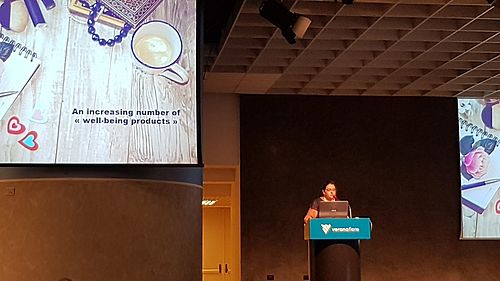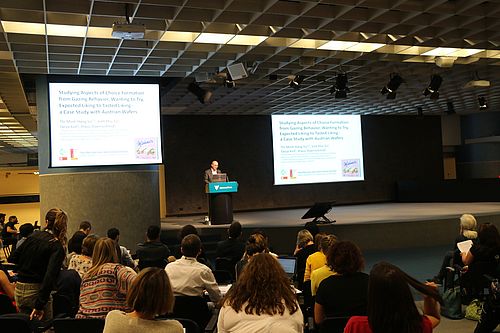EuroSense summary
How to summarize a conference? Let the participants talk. Here, we present a summary from the social media buzz around EuroSense 2018, the conference of sensory and consumer science in Verona, Italy. Around a hundred participants tweeted about the meeting and reached an online audience of more than a hundred thousand people (so twitter says).
You also can find the summary on LinkedIn.

Day 1 – Sunday 2 September 2018
Start of #EuroSense2018. Just some numbers: 727 participants (73% from Europe), 590 abstract submission, 66 oral presentations, 4 workshops, 386 posters. A lot to digest :)

Both key note speakers, John Prescott and Caterina Dinnella, emphasize: Individual differences in taste perception, liking & food choice need more attention. E.g. psychological traits such as risk aversion and alexithymia* are associated with preferences.
Learning plays an important role in food choice. “Satiation and satiety can be modified via associative learning.” - John Prescott
Caroline Withers tweets: Learning influences perception. Explains why some products can be ‘slow burners’ and gain in popularity with time. Brand communication and alignment of key sensory & conceptual cues can be key to delivering towards consumer expectations and help learning – fast.
John Hayes tweets: Echoes of RM Pangborn’s oft ignored warnings from the late 1970s – Dr. Dinnella shows that it is critical to consider segmentation versus averaging, when looking at consumer food preferences.
*Also needed to google Alexithymia? A personality construct characterized by the subclinical inability to identify and describe emotions in the self.
Day 2 – Monday 3 September 2018

The Verdi auditorium is filling up for the key note talk of Kees de Graaf, Wageningen University, "Make the healthy choice the happy choice – the role of taste in satiation". He presents some surprising results: Sweet taste correlates with carbohydrate content, but doesn´t correlate with the energy content of food. We are bad at sensing calories.
This post has become one of the most popular tweets during EuroSense and shows that “Healthy and Happy” have become important topics in sensory science: Emma Feeney tweeted, Kees de Graaf tells us that sensory science plays a vital role in nutrition – how can we make the healthy choice the happy choice?
Some titbits from the talk of Kees de Graaf:
• Eating rate is important for energy intake (the faster we eat, the higher the energy intake).
• Foods with harder consistencies reduce energy intake over the course of the day.
• Even eating apple juice with a spoon instead of drinking it will lead to earlier satiation.
• By manipulating the sip size, it is possible to double the exposure time to the taste of salt. This leads to 30 percent less food intake. Should we design slow food for better health? (https://www.sciencedirect.com/science/article/pii/S0950329318301162)

At the ESN workshop “In-context consumer research: benefits and opportunities for immersive techniques”, ESN members present their own new research results as well as the results of a cooperative ESN research programme, the “Immersive Project”. The question behind all of this is, how can sensory and consumer research benefit from immersive methods, e.g. virtual reality (VR).
By now, many people have experienced VR themselves and the wow-effect is no longer in the forefront. It is a good time to take a matter-of-fact look at the pro and cons of the new techniques. The upshot: The method is still evolving, but product developers are already using the results. At the workshop, the ESN video about the “Immersive project” had its premier. This is a good way to bring such studies, their designs and results, to life for the audience.

A lively discussion ensued during the workshop, and an important question arose from the audience: What is the added value of the new immersive techniques? The answer is still a work in progress.

Michael Sigrist, ETA Zürich asks: How helpful are health labels on food packages? Opposed to many pevious studies, healthy choice labels did not enhance consumers' ability to choose healthier foods. The ETH study used a more realistic choice task than had previous studies.

The number of wellbeing products is increasing. But how to measure a change in wellbeing with product use? Lise Dreyfuss from Biofortis designed a new and validated questionnaire. It can be used for food, supplements and cosmetics.

The workshop “Thought for food” deals with how cognition determines perceptions and preferences. Here are a couple of take-home snippets:
• Exposure to an odour enhances liking. But only if you pay attention to the odor. Exposure is not a passive process. (John Prescott)
• Attention can modulate what we perceive in a mixture of odorants. (Thierry Thomas-Danguin)
• Is odor valence driven by universals arising from molecular structure, or is valance based on learning and memory and cognition? Experimentally, odor identification is faster than valence/edibility decisions. Fascinating talk by Jonas Olofsson. (Tweet by John Hayes) Here is one of Olofsson´s latest publications: https://psyarxiv.com/bg6t8

After a day of explaining their studies to a steady stream of visitors, some of the poster presenters have hoarse voices.
Day 3 – Tuesday 4 September 2018
Day three started with a keynote from Mari Sandell, Turku University: "Individual differences in sensory perception create unique experience worlds". One of the most well-known differences in odour perception is the ability or inability to smell androstenone. "If you still haven´t had the experience of smelling androstenone, I actually have a vial in my bag and am happy to introduce this to everyone later."
Heikki Aisala tweets: Prof. Mari Sandell reminds us that while the community favorite TAS2R38* is a good indicator, there's a whole world beyond it and we are still seemingly focusing more on taste than smell receptors.
Some upshots from the talks that followed the lecture:
• There is a strong association between personality traits (anxiety, sensitivity to reward/punishment/disgust) and taste perception & liking. (Sara Spinelli)
• Is there a heritable component of sweet & taste perception? In general, low genetic heritability. A bit higher correlation between father & daughter, among siblings, for fat preference. (Hannah Jilani)
• The orosensory advances of thermaltasters to beer extends to its temporal perception. Plus: TCATA is an effective tool for simultaneously comparing products & consumers. (Margaret Thibodeau)
• Heart rate as a measure of emotion during cooking. E.g. adding curry and taking a bite raises heart rate. HR could be used as a continuous implicit measure to identify emotionally meaningful phases. (A Brouwer)
• Barriers for more sustainable food: unfamiliarity, tradition, lack of knowledge, taste, texture. For consumers, meat analogues are considered processed food therefore unnatural & unhealthy. (Paula Varela)
• Prof Frøst demonstrates that in a Danish consumer test the version of granola with visible insects was actually more liked than the one with hidden insects. (Tweet from Heikki Aisala)
* a bitter taste receptor; varying genotypes of TAS2R38 influence the ability to taste both 6-n-propylthiouracil (PROP) and phenylthiocarbamide (PTC).

The room Salieri is packed as Ludovic Depoortere, Haystack international, explains how he uses functional, emotional and sensory profiling to support chocolate innovation.

Frida Vennerod from Nofima presents one of a series of very interesting studies on the change of taste preferences during childhood. Sweetness preference grows between age 4-6. Children who are more sensitive to sweetness have a lower preference for sweet drinks. The opposite is true for bitter taste: A higher sensitivity to bitterness is associated with a higher preference for bitter chocolate. In general, research shows only a small relationship between sensitivity and preference. (Here is a video about her research https://youtu.be/8fPBI9Vdxk4)

Klaus Dürrschmid, BOKU Austria, presents the study "Studying product likers from gazing behavior." (More here: https://www.esn-network.com/news/single-view/article/heres-looking-at-you-wafer/)

A crash course in sustainability. Jessica Aschemann-Witzel, Aarhus University Denmark, delivers a fascinating talk about how sensory consumer science can contribute to sustainable development of the food sector. For those of you who flew to the conference: It is more sustainable to fly from Verona to Aarhus than to walk. Why? Because the food you eat during the one-month walking has a worse environmental impact than the flight. (More of her research: https://www.researchgate.net/profile/Jessica_Aschemann-Witzel). A lot of “Great talk” tweets accompany her presentation.
Day 4 – Wednesday 5 September 2018

It was a long night yesterday, but the conference hall filled up quickly for the key note lectures. David Morizet from L'Oréal Research & Innovation discussed "Designing sustaining and disruptive innovations with sensory & consumer science". Caroline Withers captures the essence in a tweet: Incremental innovation in sensory & consumer science can be tackled with typical techniques. If disruptive innovation is key to survive in our competitive market places, isn´t it time for our science itself to undergo some really disruptive innovation?

Paula Varela, Valerie Almli (both from Nofima) and colleagues lead the workshop on “Social responsibility: the oft forgotten side of sensory and consumer science.” Paula Varela kicks it off with an unsettling statement. “We spend a lot of time writing papers, but they get only a few citations. Where is our impact on society?”
The workshop team also highlights the need for more sensory and consumer research in less affluent countries and groups. C Gomez-Corona Field presents an example, a research in collaboration with the inhabitants of a favela in Sao Paulo: “Developing local flavors for healthier beverages for low income populations.”

At the Social Responsibility workshop, Katherine Appleton presents new data from the Kantar Study: Sugar intake is going down, but fat intake is going up at the same time. Thus, does sugar reduction in food products make sense? (More about Kantar: https://publichealthmatters.blog.gov.uk/2018/05/22/the-worlds-first-sugar-reduction-programme-data-challenges/)

Valerie Almli presents data on the challenge of food waste. (She is part of a project team at Nofima that focuses on the topic.) There are still many open questions, for example, whether use-by-dates increase or decrease food waste. One thing seems to be sure: We should rely more on our senses to find out if food is spoiled or not.

Huge interest in the talk by Marleen Chambault from Campden BRI on “Novel consumer methods for product characterization”. Samples were discriminated in much the same way across methods (E.g. RATA did not show benefits over CATA.)

Alexandra Kraus (isi Germany) presents her latest study about an innovative method, the swipe approach avoidance procedure, SWAP. The research shows promising results, but there is still some work to do before it can be put into routine use.

Sylvie Issanchou asks in her talk: What is next in sensory science? One of her picks: sugar reduction. Consumers need to experience that less salt, less fat, less sugar leads to richer sensory experiences.

The tension rises … Kees de Graaf and Betina Piqueras-Fiszman present the venue of EuroSense 2020. The conference will be hold in Rotterdam!
Thanks to the conference chair Erminio Monteleone and the organizers of #EuroSense2018 (Elsevier, Italian Taste, SISS, E3S). Thanks to everybody who contributed to these conference snapshots.